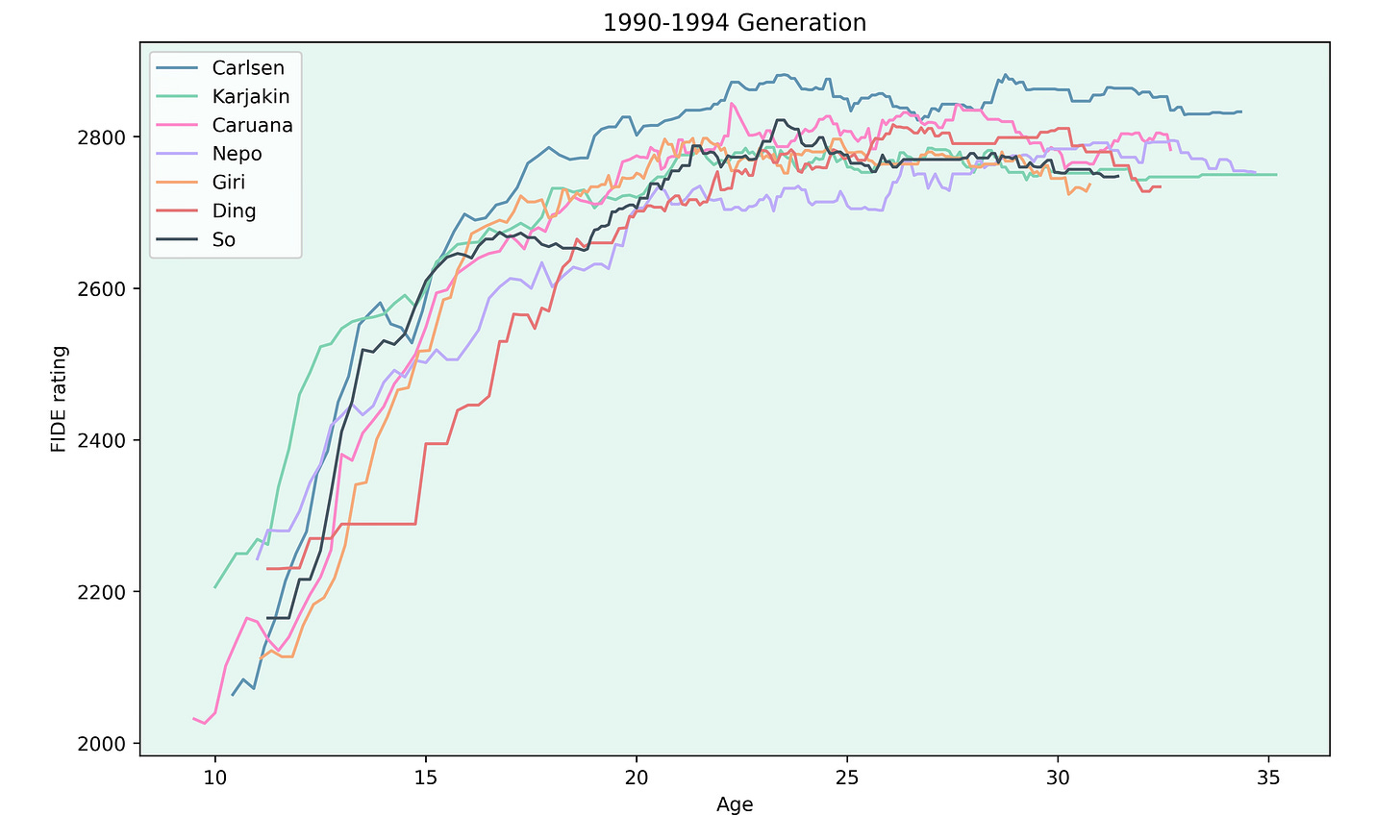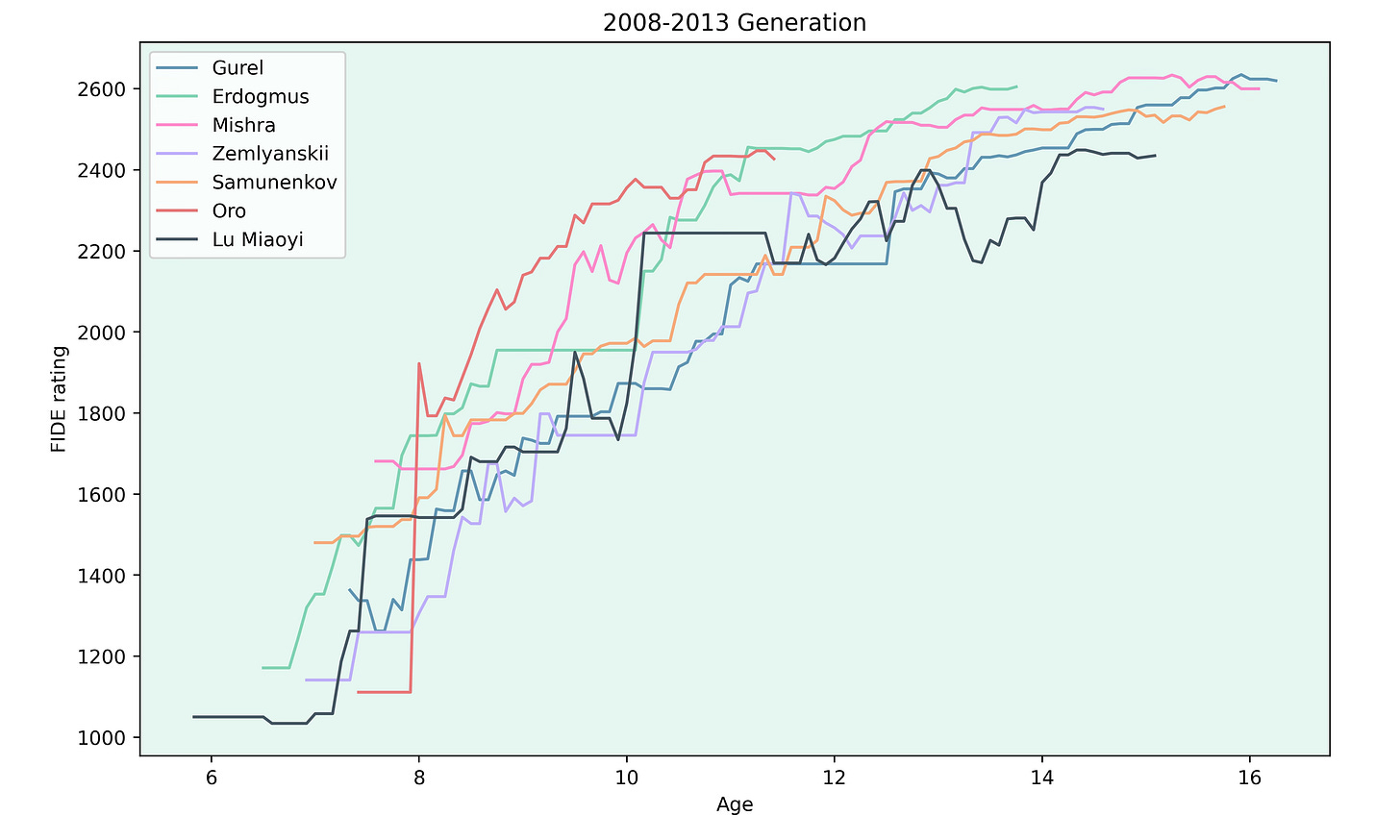Comparing the Rise of 3 Generations of Chess Prodigies
How has the climb through the ranks changed?
One thing I like about chess ratings is that they make it easy to track how players are progressing when rising through the ranks. Since it seems like young players are improving faster and faster, I wanted to take a look at how the ratings of young players develop over the years.
I look into three different generations of players, the generation born in the nineties who dominated top level chess for the past decade, the new group of top players born between 2003 and 2006 and finally the latest generation of upcoming players, born after 2008.
Note that I only picked a handful of players from each generation, mainly based on their strength today. There probably were many players with similar or even faster ascends through the ranks how didn’t break through to the very elite. Let me know if I missed any big names.
Nineties generation
I started out with the generation of players that dominated chess for the past decade. I focused on the players born between 1990 and 1994 which means that I left some players like Nakamura or Aronian out. But I didn’t want to look at too many players at once since the plot would have been too messy.
It’s really interesting to see how the different players developed over the years. It looks like Ding didn’t play many FIDE rated games in his early years as his rating looks more like a step function than a smooth curve before his late teens.
Nepo’s path to the top looks very unusual, he had a similar rating to Carlsen and Karjakin until the age of 13 but then he lost some ground to his peers and only caught up at the age of 25 after which he managed to establish himself in the elite and win the Candidate’s twice in a row.
Comparing Karjakin and Carlsen is also interesting. Karjakin was significantly higher rated before they were 15 but Carlsen’s rating growth didn’t really slow down, even after he hit 2600.
2003-2006 Generation
Now moving on to the next generation of players, the first thing to point out is that the FIDE rating floor was reduced over the years. This means that we can see the ratings for the players much earlier than before.
The first thing that stood out to me was Arjun’s progression over the years. He was always lower rated than the other players in this group until the age of 18 from where he improved steadily while to progress of other players slowed down a bit.
All players seem to have some phases where they made a sudden jump in rating, for most of them it happened around the age of 10 but it was a bit later for Firouzja and Arjun. It’s interesting that the two players who broke 2800 seemed to have the slowest start in this group of players.
2008+ Generation
Finally I want to look at the latest generation of chess prodigies rising through the ranks.
In contrast to the 2003-2006 generation, it seems that the youngest players are making a big jump in rating even before they turn 10. Their improvement seems to be in general more steady and contains less big jumps.
As with Ding, the progression of Lu Miaoyi looks more jagged than the graph of her peers because she plays less FIDE rated games. This is probably also the reason why she has more big jumps as there is more time to improve between games.
It’s interesting to see that Mishra, Erdogmus and now Oro are quite a bit ahead of their peers from the ages 8 to 12. It’ll be very interesting to follow their further progression and see how many of them will become top players in the future.
Conclusion
One thing that became clear to me is that it’s often not too important how strong a player is at younger ages. What really counts when trying to break into the elite is continued progression even as the opposition gets stronger and improvement becomes more difficult. Although all players I looked at were extremely strong for their age so the differences weren’t too big in their earlier years.
I’d have also liked to look at older players but the FIDE rating only got introduces in 1970 and until 1999 the rating lists were only published every 6 months which makes it much harder to track the development of youngsters who are improving quickly.







More like the conclusion that progress doesn't have any major pattern. With computers maybe initial rise is getting at younger age. Would be cool to look for this pattern on more number of players of each generation ( maybe looking at average)
Since the statistics of the ELO type are only making sense and depend on the variable that is the set of players and the set of games played, in "their" pool, I wonder how that floating variable, in looking over life span durations, would complement this research here.
The demographics of the pool. In fact I have difficulty or igrnorance about how the pool, of players/games driving the ELO statistics, evolved over time. The demographics dynamics surely would have some effect. But then the question of mixing across rating in the events also driving the statistics, might become a factor to consider. The tiering.
I think some of those questino might use database of full poppulation like on lichess, where one can filter non tournam,ent tiered rated game events from the ones tiered..
that could serve as some kind of control group. The round the clock and more reliable random pairing mixing policies there might offer some conparison signal with the more tiered structures population mixing of OTB.
just ideas. I might have misconception and ignorance about OTB facts that my questions might tie into.